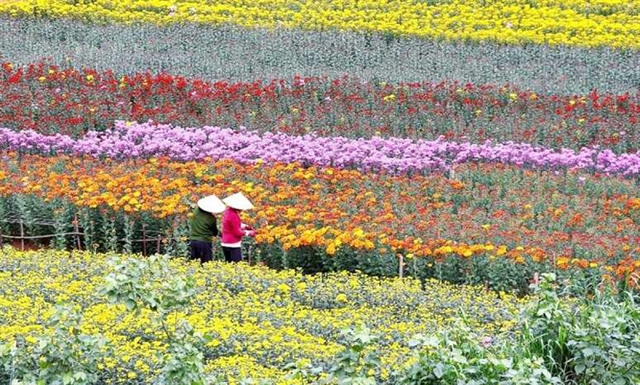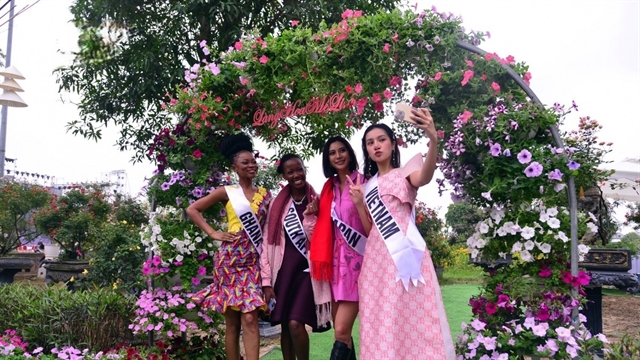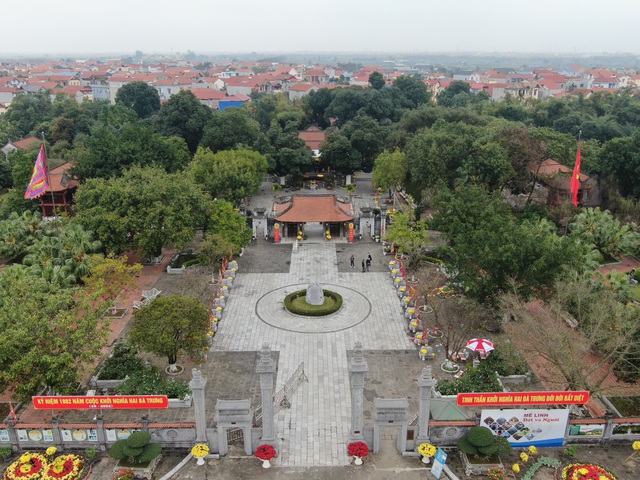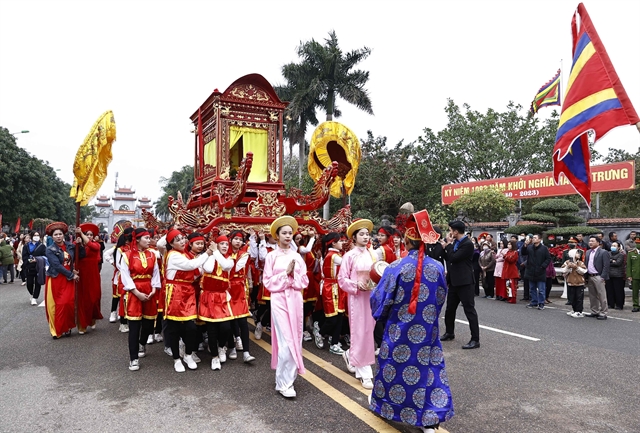Weather:
- Ha Noi 27oC
- Da Nang 29oC
- Ho Chi Minh 31oC

Thanh Hà
Roses, daisies, lilies and many beautiful bonsai trees are here and there and everywhere for visitors to see in Mê Linh, the famed flower-growing centre of Hà Nội. The district is also home to many cultural festivals and spiritual sites boasting fantastic eco-tourism.
"Here in Mê Linh, there are 161 relic sites, more than 200 typical traditional festivals and a range of tourist sites," said Hoàng Anh Tuấn, Chairman of Mê Linh District People's Committee.
"Among the relics, 25 are national relics and one is the national special relic of Hai Bà Trưng Temple where we organise the annual Hai Bà Trưng Festival.
"Visiting Mê Linh, people can admire our Hạ Lôi Flower Village, visit the President Hồ Chí Minh Memorial Area at 79 Springs Hill, and enjoy the high-tech organic agriculture zone combined with an educational farmhouse."
These advantages and good transport links have encouraged local authorities to build a plan to develop Mê Linh into a sustainable eco-tourism destination with the largest flower market in the north.
Land of flowers
Located 30km north of the capital, Mê Linh has almost 2,000ha of flowers. Farmers supply flowers to the capital and other provinces and cities across the country.
Mê Linh's is almost full of flowers all year round but farmer Phạm Đức Tài said the most beautiful time is from September to April.

"At this time, fields are covered by violets, gladiolus, mimosas, roses, daisies and lilies, bringing new colours. And we also welcome many tourists who either come to take photos, or buy flowers and bonsais," Tài told Việt Nam News.
Tài said that in addition to fresh flowers, farmers in Mê Linh now produced dried ones that last many months with their vibrant colours retained.
"Flowers are dried with hot sand from techniques we learnt from Japan. After two to three weeks, fresh flowers will be converted into dried ones with their beauty kept almost 100 per cent," he said.
He added their new products received great feedback from local customers, and they also received orders from international clients.
“Farmers here have great skills and a good aesthetic sense, so they can breed hybrid flower varieties to create such special colourful bonsais," said Đào Mạnh Tiến, a visitor from Ba Đình District.
"My family loves roses, and we often go to Mê Linh at the weekend to visit pagodas and temples, go sightseeing and shopping for ornamental plants. This flower hub is not as crowded as those in the city, and it’s not too far to travel. The atmosphere is fresh and cool. What a way to relax," he said.

Chairman Tuấn said that Mê Linh organised the first flower festival in December 2022. Entitled Mê Linh Brilliant with Flowers, the festival lured thousands of visitors to the three-day event that spanned 4,300 square metres. He said it would now be organised annually to make Mê Linh a must for flower lovers.
Land of heroines
Mê Linh is also well-known as the hometown of Việt Nam's first two female rulers, Trưng Trắc and Trưng Nhị. The sisters (who lived between 14 and 43 AD) spent their childhood, grew up and rode elephants to lead their troops to defeat the cruel Chinese Han invaders.

The sisters are considered the first heroines of the country.
The temple here is not only a sacred spiritual place where people learn about national history, but also home to many valuable and precious relic items made of wood, stone, bronze, porcelain and paper.
Imbued with traditional culture, the temple is preserved and honoured as a place for education about traditions and for cultural and religious activities. It was recognised as the National Special Relic in 2013 and named as a "Hà Nội tourist destination" in 2022.
According to Chairman Tuấn, Mê Linh is implementing a VNĐ500 billion (US$21 million) project to renovate, embellish and complete works in the temple. The work will preserve, promote, and sustain the surrounding heritage and traditional culture of the building.

Every year, the Hai Bà Trưng Temple Festival is held on lunar January 6 in Mê Linh Commune.
It opens with the procession of the king’s palanquins, fighting-elephants and offerings. The respected elders in the village are selected to beat drums and gongs, while strong men and beautiful girls carry two palanquins. Villagers display their offerings to welcome the procession.
The festival includes many cultural activities, such as traditional dances, wrestling and folk games. It was recognised as a National Intangible Cultural Heritage in 2018.
Relaxing land
In addition to cultural and spiritual hotspots, visitors can enjoy a day full of activities at the 79 Springs Hill ecotourism complex. The green and fresh environment will keep people away from the hustle and bustle of city life. It is an ideal place for camping, team building, aquatic sports, and campfires.
You can also visit Linh Ấn Pagoda, Báo Ân Temple worshipping heroes and martyrs, and one of the first-ever President Hồ Chí Minh statues here.

Touring the district's traditional craft villages is a much-loved choice of many visitors where they can buy local specialities such as peanut candies in Yên Thị Village, vermicelli noodles and rice paper in Trung Hà, as well as bamboo and rattan weaving products in Nam Cường.
Future plans
Mê Linh recently hosted a farm trip and workshop gathering many travel agencies and tourism officials of Hà Nội, who contributed their ideas to help local managers recognise the potential of tourism here.
Most agreed that Mê Linh had many advantages in the tourism industry with its long history, revolutionary tradition, and rich customs and traditions.
But there is a lack of experiential tourist products, transport is limited, and the craft village activities can be unattractive.
Tourism supporting infrastructure such as goods and souvenir shopping facilities and parking lots are not available, or they are too small and unprofessional to meet the needs of tourists.
Trần Thị Lan, deputy head of the Mê Linh's Department of Culture and Sports, said the district was aiming to turn tourism into an important economic sector by 2030.

A system of synchronous and modern facilities would be needed, and quality tourism products must be imbued with national culture and be environmentally friendly.
"We will cooperate with travel agencies to build tourist routes connecting destinations to link with the 79 Springs Hill, agricultural tourism at traditional flower-growing villages and fields of clean vegetables for people to visit," Lan said.
"We will build a chain of garden houses to grow and display high-tech flower varieties to attract tourists. We will also coordinate with partners to build tours and routes connecting with the tourist destinations of our neighbouring districts of Đông Anh and Sóc Sơn." VNS

